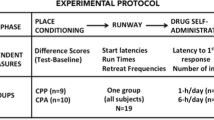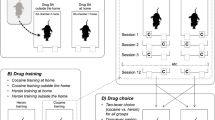Abstract
The role of drug-paired environmental stimuli in opiate self-administration was investigated by exposing animals to discrete cues that were predictive of the availability or unavailability of heroin reinforcement. Rats were trained to traverse a straight arm runway for a reinforcement consisting of a single 0.1 mg/kg intravenous infusion of heroin delivered upon entrance to the goal box. On each trial, one of two discriminative olfactory stimuli (orange and almond) was used: one which signaled the availability of heroin in the goal box (S+), and one which signaled its absence (S−). The effect of dopamine (DA) receptor antagonism on reinforcement and motivational processes was investigated by pretreating subjects with 0.0, 0.15 or 0.30 mg/kg of the DA receptor antagonist drug, haloperidol. Haloperidol had no effect on operant runway performance (i.e. goal time) in any condition. However, 24 h later, on the first post-treatment trial, those haloperidol animals that received heroin in the goal box on the previous trial (i.e. the S+ condition) ran reliably more slowly than subjects that received vehicle on the previous S+ trial. These results suggest that haloperidol does not affect the motivational properties of stimuli which predict the availability of heroin, while it does diminish the reinforcing effects of actually receiving heroin.
Similar content being viewed by others
References
Beninger RJ, Hahn BL (1983) Pimozide blocks establishment but not expression of amphetamine-produced environment-specific conditioning. Science 220: 1304–1306
Beninger RJ, Herz RS (1986) Pimozide blocks establishment but not expression of cocaine- produced environment specific conditioning. Life Sci 38: 1425–1431
Braun GA, Poos GI, Soudijn W (1967) Distribution, excretion and metabolism of neuroleptics of the butyrophenone type. II. Distribution, excretion and metabolism of haloperidol in Sprague-Dawley rats. Eur J Pharmacol 1: 58–62
Cunningham ST, Kelley AE (1992) Opiate infusion into nucleus accumbens: contrasting effects on motor activity and responding for conditioned reward. Brain Res 588: 104–114
Davis WM, Smith SG (1976) Role of conditioned reinforcers in the initiation, maintenance and extinction of drug taking behavior. Pavlov J Biol Sci 11: 222–238
Ettenberg A, Camp CH (1986a) Haloperidol induces a partial reinforcement extinction effect in rats: implications for a dopamine involvement in food reward. Pharmacol Biochem Behav 25: 813–821
Ettenberg A, Camp CH (1986b) A partial reinforcement extinction effect in water-reinforced rats intermittently treated with haloperidol. Pharmacol Biochem Behav 25: 1231–1235
Ettenberg A, Horvitz JC (1990) Pimozide prevents the response-reinstating effects of water reinforcement in rats. Pharmacol Biochem Behav 31: 861–865
Ettenberg A, Petit HO, Bloom FE, Koob GF (1982) Heroin and cocaine intravenous self-administration in rats: mediation by separate neural systems. Psychopharmacologia 78: 204–209
Ettenberg A, MacConell LA, Geist TD (1995) Effects of haloperidol in a response- reinstatement model of heroin relapse. Psychopharmacology (in press)
Fontana DJ, Post RM, Pert A (1993) Conditioned increases in mesolimbic dopamine overflow by stimuli associated with cocaine. Brain Res 629: 31–39
Franklin KBJ (1978) Catecholamines and self-stimulation: reward and performance deficits dissociated. Pharmacol Biochem Behav 9: 813–820
Franklin KBJ, McCoy SN (1979) Pimozide-induced extinction in rats: stimulus control of responding rules out motor deficit. Pharmacol Biochem Behav 11: 71–76
Gallistel CR, Boytim M, Gomita Y, Kebanoff L (1982) Does pimozide block the reinforcing effect of brain stimulation? Pharmacol Biochem Behav 17: 769–781
Geist TD, Ettenberg A (1990) A simple method for studying intravenous drug reinforcement in a runway. Pharmacol Biochem Behav 36: 703–706
Gerber GJ, Sing J, Wise RA (1981) Pimozide attenuates lever pressing for water in rats. Pharmacol Biochem Behav 14: 201–205
Goldberg SR, Schuster CR (1970) Conditioned nalorphine-induced abstinence changes: persistence in post morphine dependent monkeys. J Exp Anal Behav 14: 33–46
Hinson RE, Poulos CX, Thomas W, Cappell H (1986) Pavlovian conditioning and addictive behavior: relapse to oral self-administration of morphine. Behav Neurosci 100: 386–375
Horvitz JC, Ettenberg A (1991) Conditioned incentive properties of a food-paired conditioned stimulus remain intact during dopamine receptor blockade. Behav Neurosci 105: 536–541
Lewi PJ, Heykants JJ, Allewijn FT, Dony JG, Janssen, PA (1970) Distribution and metabolism of neuroleptic drugs. I. Pharmacokinetics of haloperidol. Arzneimittelforschung 20: 943–948
Liao RM, Fowler SC (1990) Haloperidol produces within session increments in operant response duration in rats. Pharmacol Biochem Behav 36: 191–201
O'Brien CP (1976) Experimental analysis of conditioning factors in human narcotic addiction. Pharmacol Rev 27: 533–543
O'Brien CP, Testa T, O'Brien TJ, Brady JP, Wells B (1977) Conditioned narcotic withdrawal in humans. Science 195: 1000–1002
Ohman R, Larsson M, Nilsson IM, Engel J, Carlsson A (1977) Neurometabolic and behavioral effects of haloperidol in relation to drug in serum and brain. Naunyn-Schmiedberg's Arch Pharmacol 299: 105–114
Pavlov IP (1927) Conditioned reflexes; an investigation of the physiological activity of the cerebral cortex. Oxford University Press, Oxford
Robins LN, Helzer JE, Davis DH (1975) Narcotic use in Southeast Asia and afterwards. Arch Gen Psychiatry 32: 955–961
Robinson TE, Berridge KC (1993) The neural basis of drug craving: an incentive- sensitization theory of addiction. Brain Res Rev 18: 244–291
Schuster CR, Woods JH (1968) The conditioned reinforcing effects of stimuli associated with morphine reinforcement. Int J Addict 3: 223–230
Thompson T, Ostlund W (1965) Susceptibility to readdiction as a function of the addiction and withdrawal environment. J Comp Physiol Psychol 60: 388–392
Vaillant GE (1969) The natural history of urban narcotic drug addiction — some determinants. In: Steinberg H (ed) Scientific basis of drug dependence. Churchill, London
Vezina P, Stewart J (1987) Conditioned locomotion and place preference elicited by tactile cues paired exclusively with morphine in an open field. Psychopharmacology 91: 375–380
Wikler A (1948) Recent progress in research on the neurophysiological basis of morphine addiction. Psychosom Med 36: 189–298
Wikler A (1965) Conditioning factors in opiate addiction and relapse. In: Wilner DM, Kassebaum GG (eds) Narcotics. McGraw-Hill, New York, pp 85–100
Wise RA (1982) Neuroleptics and operant behavior: the anhedonia hypothesis. Behav Brain Sci 5: 39–88
Author information
Authors and Affiliations
Rights and permissions
About this article
Cite this article
McFarland, K., Ettenberg, A. Haloperidol differentially affects reinforcement and motivational processes in rats running an alley for intravenous heroin. Psychopharmacology 122, 346–350 (1995). https://doi.org/10.1007/BF02246264
Received:
Revised:
Issue Date:
DOI: https://doi.org/10.1007/BF02246264




